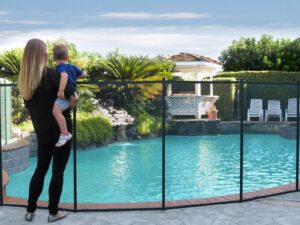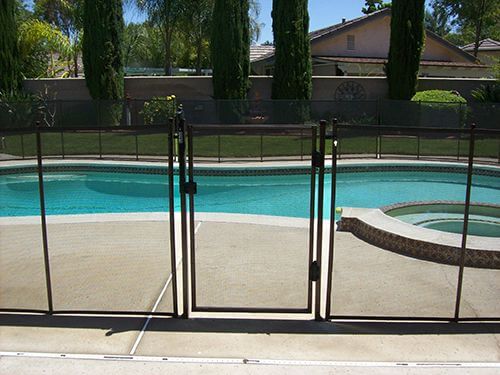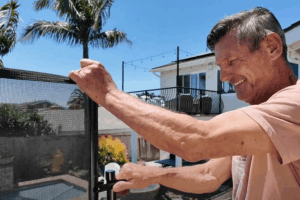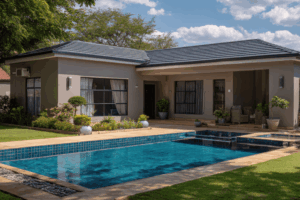
What Makes a Pool Fence Truly “Child-Safe”?
A truly child-safe pool fence does more than meet code. Discover the features parents should prioritize, and how All‑Safe builds fences that families trust.
Swimming pools not only give a lavishing look to our homes but also let us have the most enjoyable relaxing moments with our loved ones. However, as much as we may value our pools, they are a potential danger to children and may cause a lot of injuries. It is estimated that about 300 children under the age of 5 in the United States alone drown every year. A pool fence is essential for safety and in this article we will talk about the different types of pool fences that are available on the market.
Currently, there are no federal pool fence laws in place in the US. Pool barriers are regulated at the local and state level. States have their individual state pool fence laws with certain set of standards being applicable in all states. In addition to this, the International Code Council’s has outlined strong safety standards for swimming pool fences including a requirement that the pool fence must be a minimum of 48 inches tall. These safety laws help save many lives and are in place for the good of all. In the US, any structure including a tank or basin intended for swimming or recreational bathing capable of holding water to a depth of more than 24 inches is taken as a swimming pool.

When choosing a pool fence, the following recommendations should be taken into account to ensure that your fence satisfies the legal state requirements. The first and most important factor is height. Generally, most states recommend a height of 4 feet or higher. In addition to this, the fences should be impossible for a toddler to easily climb. As for the material, the fence structures come in many different forms including wood, aluminum, vinyl and mesh. Mesh fences tend to be the best type as will be discussed later due to their durability and flexibility among other factors.
Wrought Iron Fences
These are among the highest priced fences as wrought iron is quite expensive as a fencing material. Welding and piping is used to build the fence structure giving the fence a characteristic of being sturdy. However, iron rusts therefore the fence needs some regular painting and care.
These are rather sturdy and less expensive compared to the wrought fences. Their downside is that they need regular maintenance to prevent corrosion as at times the hot sun and salty water may corrode the protective coating.
Wooden Pool Fencing
They are sturdy, and have a natural look. The downside is that they block your pool view and require frequent regular maintenance with the wooden fence.
Mesh Pool Fences
As mentioned above, removable mesh pool fences are the most effective and our recommended choice for a pool fence. The mesh material is a tensioned based system that utilizes pole spacing every 30 – 36 inches and section lengths of 10 to 15 feet making them really hard to climb over. The mesh is strong and durable and it cannot be torn under normal circumstances. The flexibility of this fence makes it an easy task to roll up the fence when need comes for storage or transportation. Mesh pool fences are used and accepted by child care services for pool safety in a home where a child is being placed.

A truly child-safe pool fence does more than meet code. Discover the features parents should prioritize, and how All‑Safe builds fences that families trust.

Thinking of installing your own pool fence? Discover the benefits of DIY kits, from cost savings and flexibility to safety compliance, and how All‑Safe makes it possible.

Just got a pool? Learn what every new owner should know, from safety codes and barrier options to basic upkeep and seasonal preparation.
Enter your zip code to locate an independent installer in your area
Enter your zip code to locate an independent installer in your area
Their contact info will be shown on the next screen.
Due to the many variations in monitors, phones, and browsers, color samples and product examples may appear different on different screens. Computers and mobile devices are not all calibrated equally and color reproduction on the Internet is not precise. The same is true for printed items such as brochures and other sales literature.
In addition, the colors of our products photograph differently under different lighting conditions. For example, photos taken in full sunlight will vary from photos taken on a cloudy or overcast day. Similarly, shadows from nearby objects can affect the color and transparency of our products. If a precise color or specific shade is important, please inspect the actual color of your product prior to installation.
Many of our products’ materials are not available through typical stores and vendors and therefore must be custom manufactured specifically for our use. In order to control costs and provide you with the best value possible, our raw materials are produced in large batches and can often take several months to receive. The colors of our materials can, and often do, vary slightly from batch to batch. Although we make every effort to minimize color variations, we cannot be responsible for these differences when they occur. If a precise color or specific shade is important, please inspect the actual color of your product prior to installation.
For example, we use the name “putty” to describe some of our products. Your idea of the color “putty” may be different than someone else’s idea of “putty”. In addition, products may have the same color name but may not be the exact same color. For example, we have different shades of “black”. Please do not order using color names as your only guide. If a precise color or specific shade is important, please inspect the actual color of your product prior to installation.
If it is important that your product be an exact color or shade, it is highly recommended that you inspect the actual product prior to its installation and address any concerns with your local independent installer. Most independent installers do not offer refunds or accept returns due to color variations.